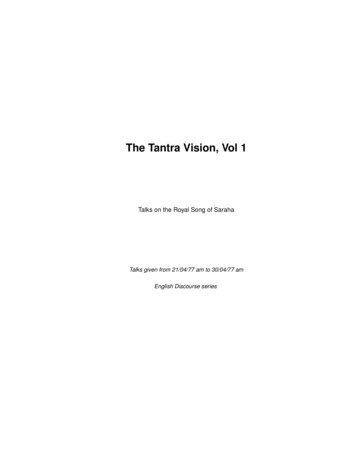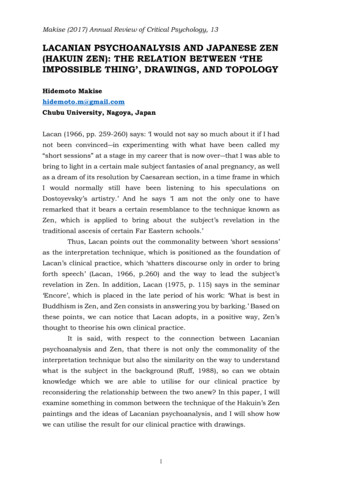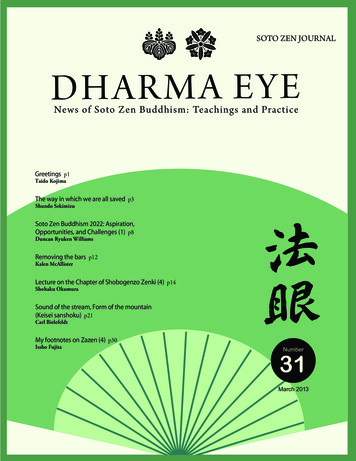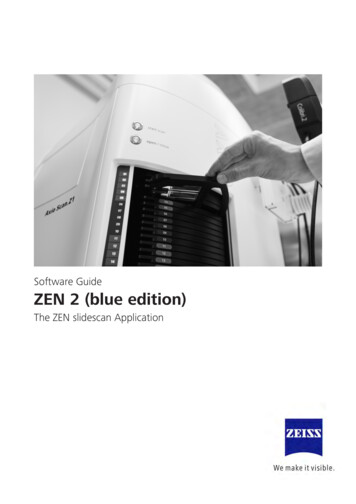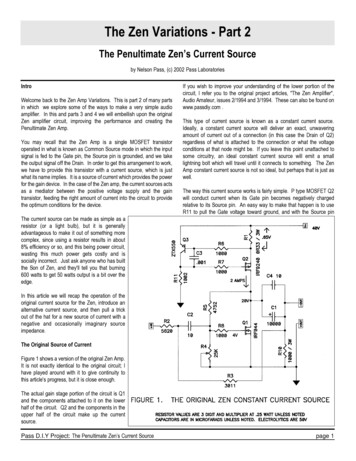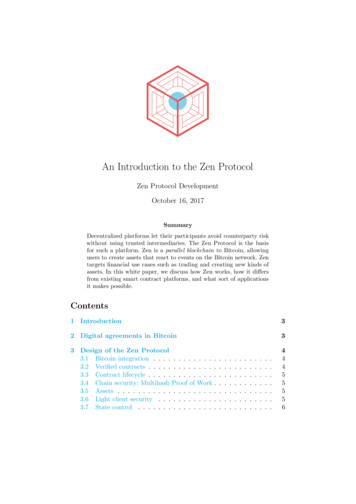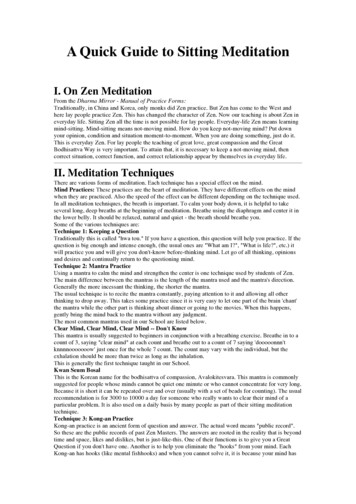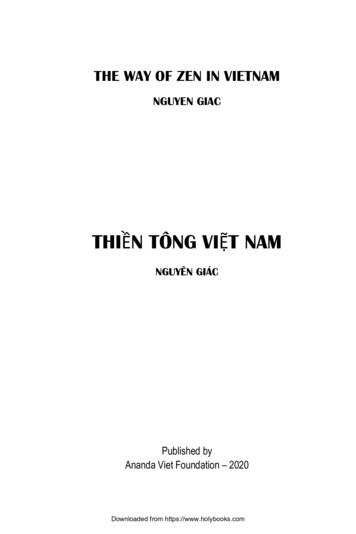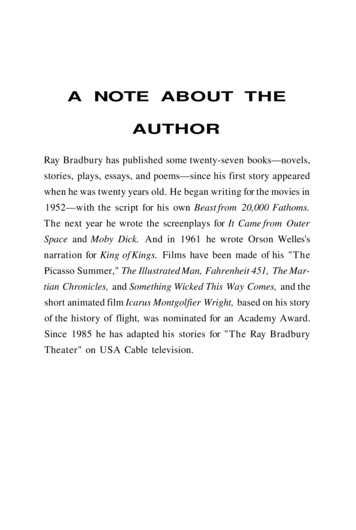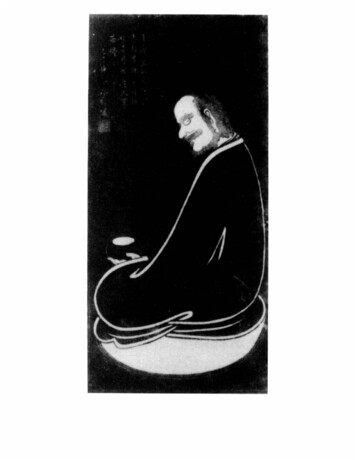
Transcription
THE ZEN TEACHINGofBodhidharmaTranslated and with anIntroduction by Red PineNORTHPOINT PRESSFarrar, Straus and GirouxNew York
Nmih Point PressA division of Farrar, Straus and Giroux18 West 18th Street, New York IOOIICopyright 1987 by Red PineAll rights reservedDistributed in Canada by Douglas & Mcintyre Ltd.Printed in the United States of AmericaOriginally published by Empty Bowl, Port Townsend, WashingtonFirst North Point Press edition, 1989Map court('sy of Ts'ai Hsun-hsiung; lettering by Paul Hansen.Cover illustration and frontispiece are rubbings of Bodhidharma from the PeilinCollection of the Shensi Provincial Museum in Sian, China.Library of Congress Cataloging-in-Publication DataBodhidhanna, 6th cent.The Zen teaching of Bodhidharma I translated and with anintroduction by Red Pine.p.em.Chinese and English.Hardcover ISBN-13: 978-o-86547-398-o (hard : alk. paper)Hardcover ISBN-10: o-86547-398-6 (hard : alk. paper)Paperback ISBN-13: 978-o-86547-399-7 (pbk.: alk.paper)Paperback ISBN-Io: o-86547-399-4 (pbk.: alk. paper)1. Zen Buddhism-Doctrines-Early works to 18oo.BQ9299.B623 E5I. Title.1989294.3'44-dc2o89009229Designed hy David Bullenwww.fsghooks.com27262524232221201918
for John Blofeld
CONTENTSIntroductiontxOutline of Practice3Bloodstream SermonWake-up Sermon47Breakthrough SermonNotes115977
INTRODUCTIONBuddhism came to China2,oooyears ago. As early as A.D. 6 5, acommunity of Buddhist monks was reported living under royal pa tronage in the northern part of Kiangsu Province, not far from thebirthplace of Confucius, and the first monks had probably arrived ahundred years earlier. Since then, tens of thousands of Indian andCentral Asian monks have journeyed to China by land and sea, butamong those who brought the teachings of the Buddha to China,none has had an impact comparable to that of Bodhidharma.Unknown to all but a few disciples during his lifetime, Bodhi dharma is the patriarch of millions of Zen Buddhists and students ofkung-fu. He is the subject of many legends as well. Along with zenand kung-fu, Bodhidharma reportedly also brought tea to China. Tokeep from falling asleep while meditating, he cut off his eyelids, andwhere they fell, tea bushes grew. Since then, tea has become the bev erage of not only monks but everyone in the Orient. Faithful to thistradition, artists invariably depict Bodhidharma with bulging, lidlesseyes.As often happens with legends, it's become impossible to separatefact from fiction. His dates are uncertain; in fact, I know at least oneBuddhist scholar who doubts that Bodhidharma ever existed. But atthe risk of writing about a man who never lived, I' ve sketched a likelybiography, based on the earliest records and a few of my own sur mises, to provide a backdrop for the sermons attributed to him.Bodhidharma was born around the year 440 in Kanchi, the cap }ital of the Southern Indian kingdom of Pallava. He was a Brahman . . 'by birth and the third son of King Simhavarman. When he wasix
young, he was converted to Buddhism, and later he received instruc tion in the Dharma from Prajnatara, whom his father had invitedfrom the ancient Buddhist heartland of Magadha. It was Prajnatarawho also told Bodhidharma to go to China. Since the traditionaloverland route was blocked by the Huns, and since Pallava had com mercial ties throughout Southeast Asia, Bodhidharma left by shipfrom the nearby port of Mahaballipuram. After skirting the Indiancoast and the Malay Peninsula for three years, he finally arrived inSouthern China around 475·At that time the country was divided into the Northern Wei andLiu Sung dynasties. This division of China into a series of northernand southern dynasties had begun in the early third century and con tinued until the country was reunited under the Sui dynasty in thelate sixth century. It was during this period of division and strife thatIndian Buddhism developed into Chinese Buddhism, with the moremilitary-minded northerners emphasizing meditation and magic andthe more intellectual southerners preferring philosophical discussionand the intuitive grasp of principles.When Bodhidharma arrived in China, in the latter part of the fifthcentury, there were approximately 2,ooo Buddhist temples and36,ooo clergy in the South. In the North, a census in 477 counted6,500 temples and nearly 8o,ooo clergy. Less than fifty years later,another census conducted in the North raised these figures to 30,oootemples and 2,ooo,ooo clergy, or about 5 percent of the population.This undoubtedly included many people who were trying to avoidtaxes and conscription or who sought the protection of the Churchfor other, nonreligious, reasons, but clearly Buddhism was spreadingamong the common people north of the Yangtze. In the South, it re mained largely confined to the educated elite until well into the sixthcentury.X
!11i .,,,,fIZ' w00z 0z.
Following his arrival in the port of Nanhai, Bodhidharma prob ably visited Buddhist centers in the South and began learning Chi nese, if he hadn't done so already on his way from India. Accordingto Tao-yuan's Transmission of the Lamp, finished in1002,Bodhi dharma arrived in the South as late as 520 and was invited to the cap ital in Chienkang for an audience with Emperor Wu of the Liang dy nasty, successor to the Liu Sung. During this meeting the emperorasked about the merit of performing religious works, and Bodhi dharma responded with the doctrine of emptiness. The emperordidn't understand, and Bodhidharma left. The earliest records, how ever, mention no such meeting.In any case, Bodhidharma crossed the Yangtze-according to leg end, on a hollow reed-and settled in the North. At first he stayednear the Northern Wei capital of Pingcheng. In 494, when EmperorHsiao-wen moved his capital south to Loyang on the northern bankof the Lo River, most of the monks living in the Pingcheng areamoved too, and Bodhidharma was probably among them. Accord ing to Tao-hsuan's Further Lives of Exemplary Monks, the first draftof which was written in 64 5, Bodhidharma ordained a monk by thename of Sheng-fu. When the capital was moved to Loyang, Sheng fu moved to the South. Since ordination normally requires a three year apprenticeship, Bodhidharma must have already been in theNorth by 490 and must have been reasonably conversant in Chineseby then.A few years later, in 496, the emperor ordered the construction ofShaolin Temple on Mount Sung, in Honan Province southeast ofLoyang. T he temple, which still exists (although largely as a touristattraction), was built for another meditation master from India, notfor Bodhidharma. But while zen masters have come and gone at thetemple for the past 1,500 years, Bodhidharma is the only monk any-Xlt
one but a Buddhist historian associates with Shaolin. It was here, onMount Sung's western Shaoshih Peak, that Bodhidharma is said tohave spent nine years in meditation, facing the rock wall of a caveabout a mile from the temple. Shaolin later became famous for train ing monks in kung-fu, and Bodhidharma is honored as the founderof this art as well. Coming from India, he undoubtedly instructed hisdisciples in some form of yoga, but no early records mention himteaching any exercise or martial art.By the year 5 oo, Loyang was one of the largest cities in the world,with a population of over half a million. When Emperor Hsuan-wudied in p6 and the Empress Dowager Ling assumed control of thegovernment, one of her first acts was to order the construction ofYung-ning Temple. T he construction of this temple and its 400-foot high pagoda nearly exhausted the imperial treasury. According to arecord of Loyang's temples written in 547 by Yang Hsuan-chih, thegolden wind-chimes that hung along the temple's eaves could beheard for three miles and the spire of the temple's pagoda could beseen over thirty miles away. Yang's account includes the commentsof a monk from the West named Bodhidharma, who called it themost imposing structure he had ever seen. Since the temple wasn'tbuilt until p6 and was destroyed by fire in 5 34, Bodhidharma musthave been in the capital around 5 20. Early records say he traveledthroughout the Loyang area, coming and going with the seasons. Inthe capital, though, he must have stayed at Yung-ming Temple. Notto be confused with Yung-ning Temple, Yung-ming had been built afew years earlier, at the beginning of the sixth century, by EmperorHsuan-wu as a headquarters for foreign monks. Before the massevacuation of the city during the collapse of the Northern Wei in 5 34,the temple reportedly housed over 3,ooo monks from countries as faraway as Syria.xm
Despite the sudden popularity of Buddhism in China, Bodhi dharma found few disciples. Besides Sheng-fu, who moved to theSouth soon after his ordination, the only other disciples mentionedare Tao-yu and Hui-k'o, both of whom are said to have studied withBodhidharma for five to six years. Tao-yu, we're told, understood theWay but never taught. It was to Hui-k'o that Bodhidharma entrustedthe robe and bowl of his lineage and, according to Tao-hsuan, a copyof Gunabhadra's translation of the Lankavatara Sutra. In the ser mons translated here, though, Bodhidharma quotes mostly from theNirvana, Avatamsaka, and Vimilakirti sutras and uses none of theterminology characteristic of the Lankavatara. Perhaps it was Hui k'o, not Bodhidharma, who thought so highly of this sutra.In his Transmission of the Lamp, Tao-yuan says that soon after hehad transmitted the patriarchship of his lineage to Hui-k'o, Bodhi dharma died in 5 28 on the fifth day of the tenth month, poisonedby a jealous monk. Tao-hsuan's much earlier biography of Bodhi dharma says only that he died on the banks of the Lo River anddoesn't mention the date or cause of death. According to Tao-yuan,Bodhidharma's remains were interred near Loyang at T inglin Templeon Bear Ear Mountain. Tao-yuan adds that three years later an of ficial met Bodhidharma walking in the mountains of Central Asia.He was carrying a staff from which hung a single sandal, and he toldthe official he was going back to India. Reports of this meetingaroused the curiosity of other monks, who finally agreed to open Bo dhidharma's tomb. But inside all they found was a single sandal, andever since then Bodhidharma has been pictured carrying a staff fromwhich hangs the missing sandal.W ith the assassination of Emperor Hsiao-wu in 5 34, the North ern Wei split into the Western and Eastern Wei dynasties, and Loyangcame under attack. Since the powerful Kao family of the Eastern Weixiv
was renowned for its patronage of Buddhism, many of the monks liv ing in Loyang, including Hui-k'o, moved to the Eastern Wei capitalof Yeh.There Hui-k'o eventually met T'an-lin.T'an-lin worked firstin Loyang and later in Yeh writing prefaces and commentaries tonew translations of Buddhist sutras.After meeting Hui-k'o, he be came interested in Bodhidharma's approach to Buddhism and addeda brief preface to the Outlineof Practice.In this preface he says thatBodhidharma came from Southern India and that following his ar rival in China, he found only two worthy disciples, Hui-k'o and Tao yu. He also says that Bodhidharma taught wall meditation and thefour practices described in the Outline.If this is all we know about Bodhidharma, why, then, is he themost famous of all the millions of monks who have studied andtaught the Dharma in China? The reason is that he alone is creditedwith bringing zen to China.Of course, zen, as meditation, had beentaught and practiced for several hundred years before Bodhidharmaarrived. And much of what he had to say concerning doctrine hadbeen said before-by Tao-sheng, for example, a hundred years ear lier.But Bodhidharma's approach to zen was unique.As he says inthese sermons, "Seeing your nature is zen.Not thinking aboutanything is zen.Everything you do is zen." While others viewedzen as purification of the mind or as a stage on the way to buddha hood, Bodhidharma equated zen with buddhahood-and buddha hood with the mind, the everyday mind.Instead of telling his disci ples to purify their minds, he pointed them to rock walls, to themovements of tigers and cranes, to a hollow reed floating across theYangtze, to a single sandal.Bodhidharma's zen was Mahayana Zen,not Hinayana Zen-the sword of wisdom, not the meditation cush ion.As did other masters, he undoubtedly instructed his disciples inBuddhist discipline, meditation, and doctrine, but he used the swordXV
that Prajnatara had given him to cut their minds free from rules,trances, and scriptures. Such a sword, though, is hard to grasp andhard to use. Small wonder that his sole successor, Hui-k'o, was a one armed man.But such a radical understanding of zen didn't originate with Bo dhidharma or with Prajnatara. It's said that one day Brahma, lord ofcreation, offered the Buddha a flower and asked him to preach theDharma. When the Buddha held up the flower, his audience was puz zled, except for Kashyapa, who smiled. This is how zen began. Andthis is how it was transmitted: with a flower, with a rock wall, witha shout. This approach, once it was made known by Bodhidharmaand his successors, revolutionized the understanding and practice ofBuddhism in China.Such an approach doesn't come across very well in books. But inhis Further Lives of Exemplary Monks, Tao-hsuan says that Bodhi dharma's teachings were written down. Most scholars agree that theOutline of Practice is one such record, but opinion is divided con cerning the other three sermons translated here. All three have longbeen attributed to Bodhidharma, but in recent years a number ofscholars have suggested that these sermons are the work of later dis ciples. Yanagida, for example, attributes the Bloodstream Sermon toa member of the Oxhead Zen School, which flourished in the seventhand eighth centuries, and he thinks that the Wake-up Sermon was aneighth-century work of the Northern Zen School and the Break through Sermon was by Shen-hsiu, the seventh-century patriarch ofthe Northern Zen School.Unfortunately, evidence that would conclusively prove or dis prove the traditional attribution is lacking. Until the present century,the earliest known copies of these sermons were fourteenth-centuryversions of Tang dynasty (618-907) originals in the collection ofxvi
Japan's Kanazawa Bunko. But with the discovery of thousands ofT'ang dynasty Buddhist manuscripts earlier this century in China'sTunhuang Caves, we now have seventh- and eighth-century copies.Clearly these sermons were compiled at a very early date by monkswho traced their ancestry to Bodhidharma. If it wasn't Hui-k'o orone of his disciples, perhaps it was T'an-lin who wrote them down.In any case, in the absence of convincing evidence to the contrary, Isee no reason why they shouldn't be accepted as the sermons of theman to whom they've been attributed for more thanr,2ooyears.Bodhidharma's disciples were few, and the Zen tradition thattraced its ancestry to him didn't begin its full flowering until nearlytwo hundred years after his death. Given the spontaneity and de tachment fostered by Bodhidharma's approach to zen, it's easy to seewhy these sermons were eventually neglected in favor of those by na tive Chinese zen masters. By comparison Bodhidharma's sermonsseem somewhat alien and bare. I only found them myself by accident,in an edition of Huang-po's Essentials on the Transmission of Mind.That was twelve years ago. Since then I' ve grown quite fond of theirbare-bones zen, and I've often wondered why they aren't more pop ular. But popular or not, here they are again. Before they fade oncemore into the dust of some crypt or library, read them through onceor twice and look for the one thing that Bodhidharma brought toChina: look for the print of the mind.Red PineBamboo Lake, TaiwanBig Cold, Year of the T igerXVII
THE ZEN TEACHINGofBodhidharma
Outline of PracticeMANY roads lead to the Path,1 but basically there are onlytwo: reason and practice. To enter by reason means to realize theessence through instruction and to believe that all living thingsshare the same true nature, which isn't apparent because it'sshrouded by sensation and delusion. T hose who turn from delusionback to reality, who meditate on walls,2 the absence of self andother, the oneness of mortal and sage, and who remain unmovedeven by scriptures are in complete and unspoken agreement withreason. Without moving, without effort, they enter, we say, byreason.To enter by practice refers to four all-inclusive practices:3suffering injustice, adapting to conditions, seeking nothing, andpracticing the Dharma.First, suffering injustice. When those who search for the Pathencounter adversity, they should think to themselves, "In countlessages gone by, I've turned from the essential to the trivial andwandered through all manner of existence, often angry withoutcause and guilty of numberless transgressions. Now, though I dono wrong, I'm punished by my past. Neither gods nor men can3
foresee when an evil deed will bear its fruit. I accept it with an openheart and without complaint of injustice." The sutras say, "Whenyou meet with adversity don't be upset, because it makes sense."With such understanding you're in harmony with reason. And bysuffering injustice you enter the Path.Second, adapting to conditions. As mortals, we're ruled byconditions, not by ourselves. All the suffering and joy we experiencedepend on conditions. If we should be blessed by some greatreward, such as fame or fortune, it's the fruit of a seed planted byus in the past. When conditions change, it ends. Why delight in itsexistence? But while success and failure depend on conditions, themind neither waxes nor wanes. T hose who remain unmoved by thewind of joy silently follow the Path.Third, seeking nothing. People of this world are deluded.They're always longing for something-always, in a word, seeking.But the wise wake up. They choose reason over custom. They fixtheir minds on the sublime and let their bodies change with theseasons. All phenomena are empty. They contain nothing worthdesiring. Calamity forever alternates with Prosperity. To dwell inthe three realms; is to dwell in a burning house. To have a body isto suffer. Does anyone with a body know peace? Those whounderstand this detach themselves from all that exists and stopimagining or seeking anything. The sutras say, "To seek is to suffer.5
To seek nothing is bliss." When you seek nothing, you're onthe Path.Fourth, practicing the Dharma.6 The Dharma is the truth thatall natures are pure. By this truth, all appearances are empty.Defilement and attachment, subject and object don't exist. Thesutras say, "The Dharma includes no being because it's free fromthe impurity of being, and the Dharma includes no self because it'sfree from the impurity of self." Those wise enough to believe andunderstand this truth are bound to practice according to theDharma. And since that which is real includes nothing worthbegrudging, they give their body, life, and property in charity,without regret, without the vanity of giver, gift, or recipient, andwithout bias or attachment. And to eliminate impurity they teachothers, but without becoming attached to form. Thus, throughtheir own practice they're able to help others and glorify the Wayof Enlightenment. And as with charity, they also practice the othervirtues. But while practicing the six virtues7 to eliminate delusion,they practice nothing at all. This is what's meant by practicing theDharma.7
Bloodstream SermonEvERYTHINGthat appears in the three realms comes fromthe mind.8 Hence buddhas9 of the past and future teach mind tomind without bothering about definitions.10But if they don't define it, what do they mean by mind?You ask. That's your mind. I answer. That's my mind. If Ihad no mind, how could I answer? If you had no mind, how couldyou ask? That which asks is your mind. Through endless kalpas11without beginning, whatever you do, wherever you are, that's yourreal mind, that's your real buddha. This mind is the buddha12 saysthe same thing. Beyond this mind you'll never find another buddha.To search for enlightenment13 or nirvana14 beyond this mind isimpossible. The reality of your own self-nature,t5 the absence ofcause and effect, is what's meant by mind. Your mind is nirvana.You might think you can find a buddha or enlightenment some where beyond the mind, but such a place doesn't exist.Trying to find a buddha or enlightenment is like trying tograb space. Space has a name but no form. It's not something you9
can pick up or put down. And you certainly can't grab it. Beyondthis mind you'll never see a buddha. The buddha is a product ofyour mind. Why look for a buddha beyond this mind?Buddhas of the past and future only talk about this mind.The mind is the buddha, and the buddha is the mind. Beyond themind there's no buddha, and beyond the buddha there's no mind.If you think there's a buddha beyond the mind, where is he? There'sno buddha beyond the mind, so why envision one? You can't knowyour real mind as long as you deceive yourself. As long as you'reenthralled by a lifeless form, you're not free. If you don't believeme, deceiving yourself won't help. It's not the buddha's fault.People, though, are deluded. They're unaware that their own mindis the buddha. Otherwise they wouldn't look for a buddha outsidethe mind.Buddhas don't save buddhas. If you use your mind to lookfor a buddha, you won't see the buddha. As long as you look for abuddha somewhere else, you'll never see that your own mind is thebuddha. Don't use a buddha to worship a buddha. And don't usethe mind to invoke a buddha!6 Buddhas don't recite sutras.17 Bud dhas don't keep precepts.18 And buddhas don't break precepts.Buddhas don't keep or break anything. Buddhas don't do good orevil.To find a buddha, you have to see your nature.19 Whoeversees his nature is a buddha. If you don't see your nature, invokingbuddhas, reciting sutras, making offerings, and keeping preceptsare all useless. Invoking buddhas results in good karma, recitingsutras results in a good memory; keeping precepts results in aII
good rebirth, and making offerings results in future blessings-butno buddha.If you don't understand by yourself, you'll have to find ateacher to get to the bottom of life and death.20 But unless he seeshis nature, such a person isn't a teacher. Even if he can recite theTwelvefold Canon,21 he can't escape the Wheel of Birth and Death.22He suffers in the three realms without hope of release.Long ago, the monk Good Star23 was able to recite the entireCanon. But he didn't escape the Wheel, because he didn't see hisnature. If this was the case with Good Star, then people nowadayswho recite a few sutras or shastras24 and think it's the Dharma arefools. Unless you see your mind, reciting so much prose is useless.To find a buddha all you have to do is see your nature. Yournature is the buddha. And the buddha is the person who's free: freeof plans, free of cares. If you don't see your nature and run aroundall day looking somewhere else, you'll never find a buddha. Thetruth is, there's nothing to find. But to reach such an understandingyou need a teacher and you need to struggle to make yourselfunderstand. Life and death are important. Don't suffer them invain. T here's no advantage in deceiving yourself. Even if you havemountains of jewels and as many servants as there are grains ofsand along the Ganges, you see them when your eyes are open. ButIJ
what about when your eyes are shut? You should realize then thateverything you see is like a dream or illusion.If you don't find a teacher soon, you'll live this life in vain.It's true, you have the buddha-nature. But without the help of ateacher you'll never know it. Only one person in a million becomesenlightened without a teacher's help.If, though, by the conjunction of conditions, someone under stands what the Buddha meant, that person doesn't need a teacher.Such a person has a natural awareness superior to anything taught.But unless you're so blessed, study hard, and by means of instructionyou'll understand.People who don't understand and think they can do so withoutstudy are no different from those deluded souls who can't tell whitefrom black.25 Falsely proclaiming the Buddhadharma, such personsin fact blaspheme the Buddha and subvert the Dharma. Theypreach as if they were bringing rain. But theirs is the preaching ofdevils,26 not of buddhas. Their teacher is the King of Devils andtheir disciples are the Devil's minions. Deluded people who followsuch instruction unwittingly sink deeper in the Sea of Birth andDeath.Unless they see their nature, how can people call themselvesbuddhas? They're liars who deceive others into entering the realmof devils. Unless they see their nature, their preaching of the Twelve fold Canon is nothing but the preaching of devils. Their allegianceis to Mara, not to the Buddha. Unable to distinguish white fromblack, how can they escape birth and death?Whoever sees his nature is a buddha; whoever doesn't is amortal. But if you can find your buddha-nature apart from yourIJ
mortal nature, where is it? Our mortal nature is our buddha nature. Beyond this nature there's no buddha. T he buddha is ournature. There's no buddha besides this nature. And there's nonature besides the buddha.But suppose I don't see my nature, can't I still attain enlight enment by invoking buddhas, reciting sutras, making offerings,observing precepts, practicing devotions, or doing good works?No, you can't.Why not?If you attain anything at all, it's conditional, it's karmic. Itresults in retribution. It turns the Wheel. And as long as you'resubject to birth and death, you'll never attain enlightenment. Toattain enlightenment you have to see your nature. Unless you seeyour nature, all this talk about cause and effect is nonsense. Buddhasdon't practice nonsense. A buddha is free of karma,27 free of causeand effect. To say he attains anything at all is to slander a buddha.What could he possibly attain? Even focusing on a mind, a power,an understanding, or a view is impossible for a buddha. A buddhaisn't one-sided. T he nature of his mind is basically empty, neitherpure nor impure. He's free of practice and realization. He's free ofcause and effect.A buddha doesn't observe precepts. A buddha doesn't dogood or evil. A buddha isn't energetic or lazy. A buddha is someonewho does nothing, someone who can't even focus his mind on abuddha. A buddha isn't a buddha. Don't think about buddhas. IfI7
you don't see what I'm talking about, you'll never know your ownmind.People who don't see their nature and imagine they canpractice thoughtlessness all the time are liars and fools. They fallinto endless space. They're like drunks. They can't tell good fromevil. If you intend to cultivate such a practice, you have to see yournature before you can put an end to rational thought. To attainenlightenment without seeing your nature is impossible.Still others commit all sorts of evil deeds, claiming karmadoesn't exist. They erroneously maintain that since everything isempty, committing evil isn't wrong. Such persons fall into a hell ofendless darkness with no hope of release. Those who are wise holdno such conception.But if our every movement or state, whenever it occurs, is themind, why don't we see this mind when a person's body dies?The mind is always present. You just don't see it.But if the mind is present, why don't I see it?Do you ever dream?Of course.When you dream, is that you?Yes, it's me.I9
And is what you're doing and saying different from you?No, it isn't.But if it isn't, then this body is your real body. And this realbody is your mind. And this mind, through endless kalpas withoutbeginning, has never varied. It has never lived or died, appearedor disappeared, increased or decreased. It's not pure or impure,good or evil, past or future. It's not true or false. It's not male orfemale. It doesn't appear as a monk or a layman, an elder or anovice, a sage or a fool, a buddha or a mortal. It strives for norealization and suffers no karma. It has no strength or form. It'slike space. You can't possess it and you can't lose it. Its movementscan't be blocked by mountains, rivers, or rock walls. Its unstoppablepowers penetrate the Mountain of Five Skandhas28 and cross theRiver of Samsara.29 No karma can restrain this real body. But thismind is subtle and hard to see. It's not the same as the sensualmind. Everyone wants to see this mind, and those who move theirhands and feet by its light are as many as the grains of sand alongthe Ganges, but when you ask them, they can't explain it. They'relike puppets. It's theirs to use. Why don't they see it?The Buddha said people are deluded. This is why when they2I
act they fall into the River of Endless Rebirth. And when they tryto get out, they only sink deeper. And all because they don't seetheir nature. If people weren't deluded, why would they ask aboutsomething right in front of them? Not one of them understands themovement of his own hands and feet. The Buddha wasn't mistaken.Deluded people don't know who they are. Something so hard tofathom is known by a buddha and no one else. Only the wise knowthis mind, this mind called dharma-nature, this mind called libera tion. Neither life nor death can restrain this mind. Nothing can.It's also called the Unstoppable Tathagata,30 the Incomprehensible,the Sacred Self, the Immortal, the Great Sage. Its names vary butnot its essence. Buddhas vary too, but none leaves his own mind.The mind's capacity is limitless, and its manifestations areinexhaustible. Seeing forms with your eyes, hearing sounds withyour ears, smelling odors with your nose, tasting flavors with yourtongue, every movement or state is all your mind. At every moment,where language can't go, that's your mind.The sutras say, "A tathagata's forms are endless. And so is hisawareness." Th
Bloodstream Sermon 9 Wake-up Sermon 4 7 Breakthrough Sermon 77 Notes 115 . INTRODUCTION Buddhism came to China 2,ooo years ago. As early as A.D. 6 5, a community
